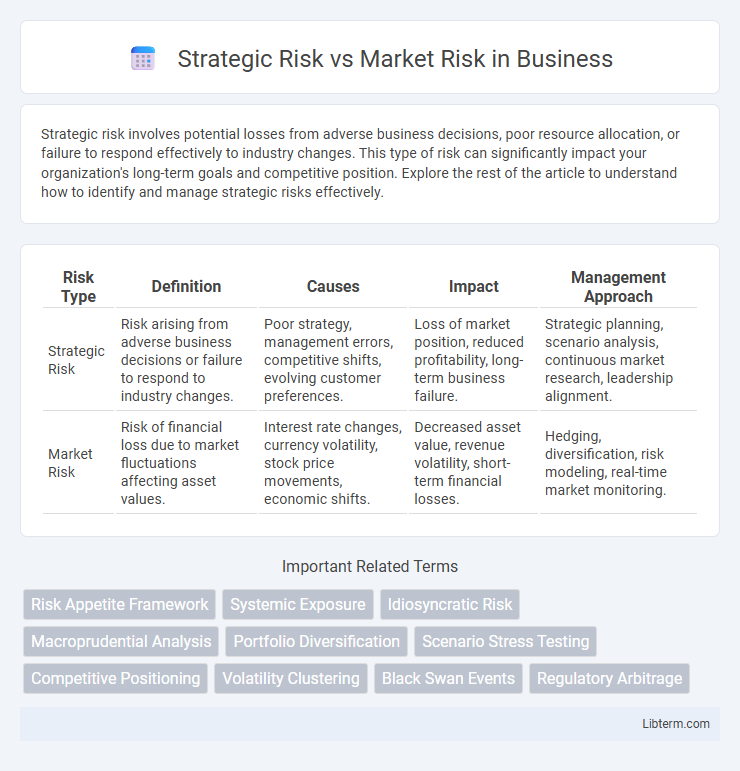Strategic risk involves potential losses from adverse business decisions, poor resource allocation, or failure to respond effectively to industry changes. This type of risk can significantly impact your organization's long-term goals and competitive position. Explore the rest of the article to understand how to identify and manage strategic risks effectively.
Table of Comparison
| Risk Type | Definition | Causes | Impact | Management Approach |
|---|---|---|---|---|
| Strategic Risk | Risk arising from adverse business decisions or failure to respond to industry changes. | Poor strategy, management errors, competitive shifts, evolving customer preferences. | Loss of market position, reduced profitability, long-term business failure. | Strategic planning, scenario analysis, continuous market research, leadership alignment. |
| Market Risk | Risk of financial loss due to market fluctuations affecting asset values. | Interest rate changes, currency volatility, stock price movements, economic shifts. | Decreased asset value, revenue volatility, short-term financial losses. | Hedging, diversification, risk modeling, real-time market monitoring. |
Understanding Strategic Risk: Definition and Key Features
Strategic risk refers to potential losses arising from adverse business decisions or improper implementation of strategies that impact an organization's long-term objectives. Key features include its origin from internal decisions, uncertainty in market conditions, and the influence of competitor actions, making it distinct from market risk, which stems primarily from external financial market fluctuations. Recognizing strategic risk involves assessing organizational goals, resource allocation, and adaptive capacity to changing environments.
What is Market Risk? Core Concepts and Examples
Market risk refers to the potential for financial losses due to fluctuations in market prices, interest rates, foreign exchange rates, or commodity prices. Core concepts include volatility, systematic risk, and exposure to broad market movements impacting asset values. Examples of market risk encompass stock price declines during economic downturns, interest rate spikes affecting bond portfolios, and currency exchange losses in multinational operations.
Strategic Risk vs Market Risk: Core Differences
Strategic risk arises from a company's business decisions, such as entering new markets or launching products, which can impact long-term objectives and competitive positioning. Market risk involves fluctuations in asset prices, interest rates, and exchange rates that affect portfolio values and financial returns. Unlike market risk, which is often quantifiable and short-term, strategic risk is qualitative, linked to management decisions, and influences overall corporate strategy.
Sources of Strategic Risk in Modern Businesses
Sources of strategic risk in modern businesses primarily arise from shifts in consumer preferences, technological advancements, and regulatory changes that alter competitive landscapes. Internal factors such as poor leadership decisions, flawed business models, and inadequate resource allocation also contribute significantly to strategic risk. Unlike market risk, which stems from external financial market fluctuations, strategic risk directly impacts long-term business objectives and organizational sustainability.
Major Drivers Behind Market Risk
Market risk primarily arises from fluctuations in asset prices, interest rates, currency exchange rates, and commodity prices that directly impact portfolio values. Key drivers include economic indicators, geopolitical events, monetary policy changes, and market liquidity levels, which can cause significant volatility in financial markets. Unlike strategic risk, market risk is inherently tied to external market conditions and investor sentiment rather than internal business decisions.
The Impact of Strategic Risk on Long-term Growth
Strategic risk directly affects long-term growth by influencing a company's ability to adapt to market changes and maintain competitive advantage, often leading to sustained financial performance or decline. Unlike market risk, which involves short-term fluctuations in asset prices or economic conditions, strategic risk encompasses decisions about business models, product innovation, and market positioning that determine future viability. Effective management of strategic risk ensures alignment with evolving customer needs and technological advancements, fostering consistent revenue growth and shareholder value over time.
How Market Risk Influences Business Performance
Market risk, driven by fluctuations in interest rates, currency exchange rates, and commodity prices, directly impacts a company's financial stability and cash flows. Volatility in market conditions can lead to unpredictability in revenue streams and asset valuations, affecting profitability and strategic decision-making. Effective risk management strategies are essential to mitigate market risk's influence on business performance and maintain competitive advantage.
Methods to Identify and Assess Strategic Risks
Strategic risks are identified and assessed through comprehensive environmental scanning, SWOT analysis, and scenario planning, enabling organizations to anticipate competitive threats and shifts in market conditions. Risk mapping and key risk indicators (KRIs) provide quantitative and qualitative measures to monitor the probability and impact of strategic uncertainties. Integrating strategic risk assessment into enterprise risk management frameworks ensures continuous evaluation aligned with organizational objectives and long-term value creation.
Effective Strategies for Managing Market Risk
Effective strategies for managing market risk include diversification across asset classes and geographies to reduce exposure to overall market volatility. Utilizing hedging instruments such as options, futures, and swaps allows firms to mitigate potential losses from adverse market movements. Continuous monitoring of market trends and implementing stop-loss orders further enhance risk control and protect investment portfolios against sudden market shifts.
Integrating Strategic and Market Risk Management for Resilience
Integrating strategic and market risk management enhances organizational resilience by aligning long-term business objectives with real-time market dynamics. A holistic risk framework leverages data analytics and scenario planning to identify vulnerabilities across strategic initiatives and market fluctuations. This integration enables proactive decision-making, minimizing potential losses and capitalizing on emerging opportunities in volatile environments.
Strategic Risk Infographic

 libterm.com
libterm.com